HIGHLIGHTS: March 31, 2023
• Harden cautiously upbeat for 2023 U.S. dairy export growth
• Speaker highlights
• CoBank’s take on ag’s role in feeding the world
• China potential remains strong
• Market outlook for 2023
• Gottlieb on the U.S. FDA
• Ingredient Committee leadership changes
• Board meeting presentations soon online
• Capitol Hill "fly-in" highlights dairy priorities
• Register now! World Dairy Summit
• Back-to-back marketing activities in Panama
• Castaneda strengthens relationships in Mexico
• USDEC urges port contract resolution
• New South Korea Trends and Insights Snapshot
Featured
Harden assesses state of U.S. dairy exports
After three consecutive years of record-setting exports, what’s next for USDEC members?
That’s the question USDEC President and CEO Krysta Harden addressed at USDEC’s Spring Board of Directors Meeting held Monday through Wednesday in Washington, D.C.
Harden’s answer: Consistency and commitment will fuel ongoing export growth. In recent years, U.S. dairy exporters have shown that they can overcome obstacles, breaking records as they faced COVID, a supply-chain crisis and other challenges.
“The message to our dairy customers around the world is that we will consistently meet their needs now and as their demand grows in the future,” said Harden.

USDEC President and CEO Krysta Harden poses with Rep. Dusty Johnson (R-SD) after a session addressing Congress’ outlook on agricultural issues.
In 2022, the United States set new records for dairy export volume (2.4 million metric tons, milk solids equivalent), value ($9.6 billion) and percentage of U.S. milk production exported (18%). It was another step in a steady international expansion of U.S. dairy, facilitated by USDEC, which was founded by Dairy Management Inc. with dairy checkoff program funding.
In a Q&A session with USDEC members, Harden was asked if 2023 would yield another record for the percentage of U.S. milk production exported. Citing challenging headwinds, including the “wild card” of China, Harden remained cautiously upbeat, saying, “We might not grow as much as we have been growing, but we're hoping for a little bit more.”
Global is the way forward
It's clear, said Harden, that the U.S. dairy industry needs exports and sees it as an engine for growth. “Where would we be without that 18% going to exports,” Harden asked rhetorically. “That would be a pretty big drain.”
The United States’ growth as a committed, consistent global dairy supplier delivering a portfolio of products suiting the needs of overseas buyers has driven U.S. dairy exports for decades, with USDEC there every step of the way.
In 2022 alone, USDEC staff traveled a combined 2.6 million air miles—the equivalent of five round-trip visits to the moon—for a broad array of activities aimed at building demand for U.S. exports and facilitating trade flows.
Looking years into the future, the market dynamics that have helped carry U.S. dairy exports to this point remain favorable. A rising global population, growing middle class and the need for sustainable, affordable nutrition are expected to drive world dairy consumption, benefitting U.S. exports.
Harden captured the determined optimism of the three-day meeting when she told attendees, “The long-term outlook for U.S. dairy exports is extremely bright. We are poised for continued growth.”
High-level officials, executives share dairy trade expectations
While Harden’s remarks set the tone for the meeting, USDEC secured a list of high-level government officials and business executives to offer their expert opinions on dairy trade challenges and opportunities, from prospects for free trade agreements to geographic indications to dairy alternatives. The lineup included:
- U.S. Representative Dusty Johnson’s assessment of the political landscape for agricultural issues and the need for improved market access for exports.
- Scott Gottlieb, former Food and Drug Administration commissioner, on the FDA’s role in facilitating agricultural trade and his experiences leading the agency.
- Ambassador Doug McKalip, chief agricultural negotiator at the Office of the United States Trade Representative (USTR), and Alexis Taylor, under secretary for trade and foreign agricultural affairs at USDA, about the 2023 agricultural trade landscape.
- A discussion about strengthening global connections with Michelangelo Margherita, head of trade section of the European Commission; Lloyd Day, deputy director general of the Inter-American Institute for Cooperation on Agriculture, and Ambassador Esteban Moctezuma, Ambassador Extraordinary and Plenipotentiary of Mexico to the United States of America.
- Tom Halverson, CEO of CoBank, providing a primer on globalization and deglobalization and ag’s role in feeding the world.
- James Caffyn, partner, Lever VC, on the evolution of plant-based and fermentation-derived dairy alternatives and how they relate to dairy.
USDEC thanks all the speakers for their time and for sharing their expertise. Additional recaps of key points from the Gottlieb and Halverson sessions follow, as well as summaries of staff presentations on USDEC’s Market Outlook and China.
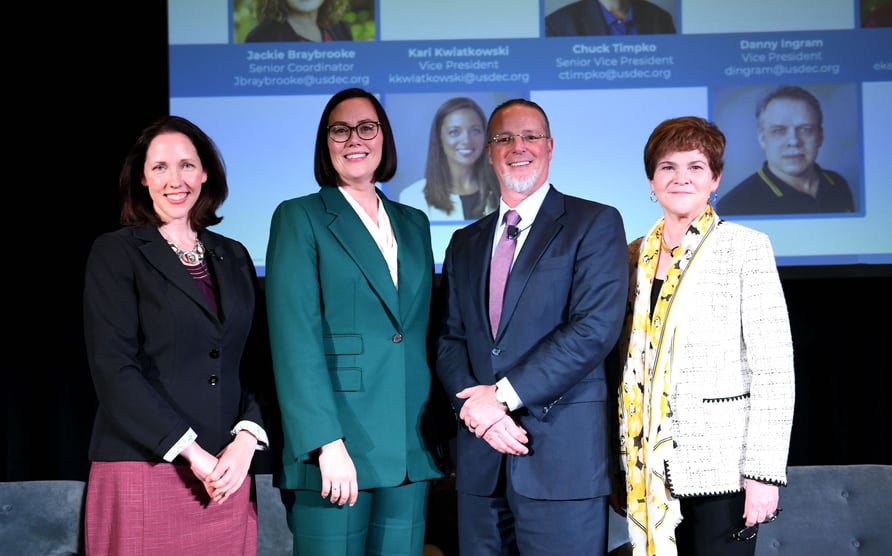
Left to right: Shawna Morris, senior vice president, Trade Policy; Alexis Taylor, USDA undersecretary for trade and foreign agricultural affairs; Ambassador Doug McKalip, USTR chief agricultural negotiator, and Krysta Harden, USDEC president and CEO.
Halverson highlights U.S. agriculture’s role in global food security
Tom Halverson, president and CEO of CoBank, outlined the history of globalization, the current trend toward deglobalization and the vital role that agriculture plays in nourishing the world.
By 2050, there will be somewhere between two and two and a half billion more people on Earth than there are now, Halverson said. Most of that growth will predominantly be in India, China, Southeast Asia and sub-Saharan Africa. “And most of those places don’t have the capacity to feed their own populations today, let alone the two billion more people that we are going to have. So, it’s really a tremendous opportunity for us (who live in areas where enough food is grown that it can be exported),” he added.
But it takes perseverance and persistence on the part of exporters to build relationships in many parts of the world, he said, citing Japan as an example. In Japan, “you don’t even talk about business the first time you meet somebody. You just break bread together and talk about your family. You’ve got to keep doing it (in subsequent meetings) and eventually you can talk about business. It takes a long time.”
China is front and center when it comes to population growth and the need to build positive outcomes.
“The most important bilateral relationship for the planet for the rest of my life is the relationship between the United States and China,” Halverson said. “A war between the United States and China would be a catastrophe unlike anything the world has ever experienced,” he added. “We have to have an interdependent relationship that’s mutually beneficial with China.”
The agricultural goods needed to help feed China’s population can be a cornerstone of that relationship.
China remains a high-potential U.S. dairy export market
China’s overall dairy imports plunged in 2022—by more than 350,000 MT compared to the previous year. And recent news reports have highlighted a shrinking population, suggesting a declining consumer base.
Neither should dissuade U.S. dairy exporters, said Daniel Chan, president of USDEC’s China office. First, U.S. suppliers increased dairy exports to China by 10% in 2022 and saw their share of the Chinese dairy import market grow by four percentage points. Second, China’s growing middle class and early-stage familiarity with dairy still point to considerable upside ahead.
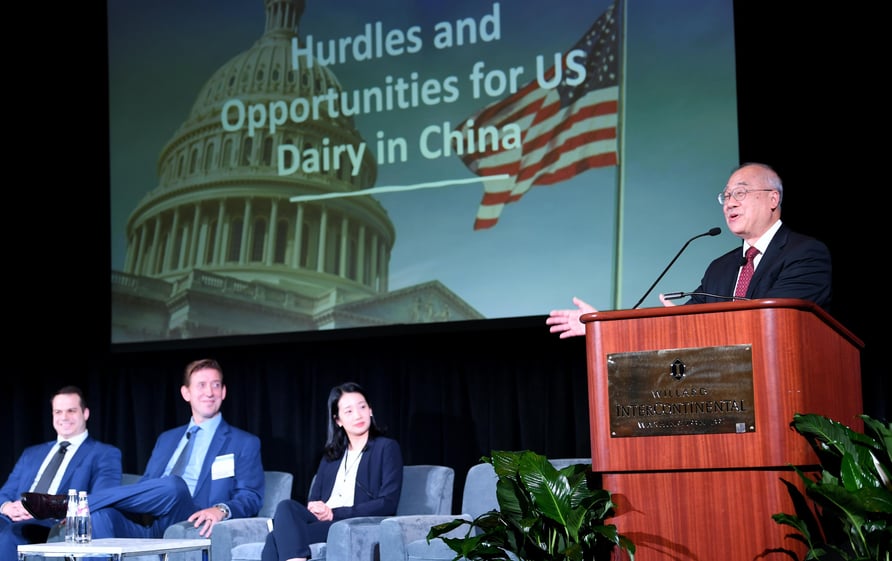
Daniel Chan (right), president of USDEC’s China office, discusses Chinese dairy demand during the session “Hurdles and Opportunities for U.S. Dairy in China.” Also on the panel were (left to right) Tony Rice, manager, Trade Policy; Eddy Fetzer, vice president, Market Access and Regulatory Affairs; and Virginia Chan, executive director of USDEC’s China office. Annie Bienvenue (not pictured), USDEC vice president, Global Ingredients Technical Marketing Services, moderated the session.
Chan said that the middle class, defined in China as a household of three with $15,000 to $74,000 in annual income, is about 400 million people, more than the entire population of the United States. While China’s total population is expected to decline, the Chinese middle class is projected to grow 45% to 582 million people by 2025. The increasing purchasing power of this middle class presents an opportunity for U.S. dairy exporters, said Chan.
“For the Chinese middle-class family, going to Pizza Hut is like going to a banquet,” said Chan. “It’s a treat. They acquire that taste and aspire to that lifestyle.”
While opportunities abound in China, so do stubborn challenges. A significant obstacle to U.S. dairy export success is the disadvantage U.S. competitors face due to free trade agreements favoring competitors.
New Zealand is China’s largest dairy supplier, taking advantage of 0% tariffs on many products, including milk powders, said Virginia Chan, executive director of USDEC’s China office. “We simply don’t have a level playing field in China with our competitors,” she added.
Signs point to slower U.S. dairy export growth in 2023
USDEC’s Economics team expressed differing opinions on their expectations for U.S. dairy export performance in 2023 at the Membership Meeting’s Market Outlook session. But one area that generated consensus was that U.S. dairy export volume growth in 2023 is unlikely to match 2022’s lofty 5% increase (milk solids equivalent or MSE).
U.S. dairy exporters face a series of challenges in 2023, including a weaker price environment, improved dairy supply out of the EU, uncertain Chinese demand and major questions about the global economy. That being said, William Loux, USDEC director, Economic Research and Analysis, expects solid demand for U.S. dairy ingredients in key growth markets, like nonfat dry milk/skim milk powder in Mexico and high-value whey in Japan, will still fuel a gain of more than 1.5% MSE.
In real-time audience polling, 58% of attendees sided with Loux, expecting U.S. MSE export growth to top 1.5%.

Left to right: Stephen Cain, Peter Vitaliano and Will Loux provide the market outlook.
A few projections
Working off of baseline estimates, Loux, Stephen Cain, USDEC director, Economic Research and Analysis, and Peter Vitaliano, NMPF vice president, Economic Policy and Market Research, provided over/under forecasts on a series of key stats, including U.S. and EU milk production, Mexican NFDM/SMP demand, Chinese WMP demand, Latin American cheese demand, Japanese WPC80+ demand, and the all-milk price. While unanimity eluded them across the board, here are some of their estimates as well as audience opinions expressed in real-time polling:
- U.S. and EU milk production: While compressed farmer margins will provide milk production headwinds globally, both the U.S. and EU should exceed 2022 growth rates. The majority opinion expects U.S. milk solids production growth to top 1.3% and component-adjusted EU milk deliveries to expand by more than 0.4%. (U.S. growth in 2022 was 1% while EU fell 0.4%.)
Sixty percent of the audience agreed that U.S. milk production would exceed 1.3%, but the audience was split virtually down the middle on the EU.
- NFDM/SMP exports to Mexico and cheese exports to Latin America: Loux sees favorable NFDM/SMP prices, a stronger peso, limited Mexican milk production growth and the Mexican election year supporting Mexican import growth in excess of 9.5% this year. Long-term cheese demand trends and reduced competition from analogues should drive Latin American cheese import growth higher than +1.5%. But Cain was skeptical on both numbers, citing growing pessimism around Latin American economic growth in 2023.
The audience went both ways: A whopping 94% said Latin American cheese import growth would top +1.5%, but 57% said the change in Mexican NFDM/SMP purchasing would be lower than +9.5%.
- Chinese WMP imports: A 30% increase in Chinese WMP imports would get the nation halfway back on its long-term growth trend. While all agreed imports would rebound this year, the majority opinion expects less than 30% growth, a belief echoed by 77% of the audience.
- Chinese whey imports: After gaining 4.6% in 2022, a decline of 1.6% would put Chinese whey imports back on its long-term trend. Even with the threat of low pork prices and signs of a potential African Swine Fever recurrence, the majority expect Chinese whey imports to exceed -1.6% growth in 2023—56% of the audience were in agreement.
- WPC80+ exports to Japan: Japanese WPC80+ demand has soared in recent years, with a compound annual growth rate of +28% from 2020-2022. The pandemic and consumers’ desire for better nutrition helped drive a lineup of new product rollouts. Cain and Vitaliano expect that with the pandemic waning and new product development likely tapering off, growth this year would revert to less than the long-term trend of +4.1%. Sixty-two percent of the audience disagreed and sided with the over.
Gottlieb offers advice on interacting with FDA
Dr. Scott Gottlieb, physician and former Food and Drug Administration commissioner, sat down with USDEC President and CEO Krysta Harden to discuss topics ranging from U.S. infant formula challenges to FDA’s relationship with USDA to notable events during his time leading the agency. To cap off the discussion, Harden asked how the dairy industry could work better with the federal agency charged with protecting and promoting public health through the control and supervision of food products.
“I would try to make sure you have multiple touchpoints” with the FDA, he said. Instead of one big dairy company trying to come in to speak to the FDA commissioner or staff, Gottlieb suggested doing it through a trade association with several companies coming in at the same time. Such meetings were instructive during his time heading the agency, he said, because they served as a prelude to what the industry would later be saying on Capitol Hill. It was “helpful to hear it first,” he said.
Changes on USDEC’s ingredients committee
USDEC’s Global Ingredients Committee is under new leadership. Due to the retirement of Keith Gretenhart of Valley Queen Cheese, vice chair of the committee, Milk Specialties Global’s Jing Hagert has assumed the role as chair. Greg Rodriguez of MCT Dairies will serve as the new vice chair.
Board meeting presentations soon available online
If you missed the March 27-29 USDEC Spring Membership Meeting—or want to rewatch a particular presentation—USDEC will post the slide decks and video recordings of many of the speakers in the coming days. Keep an eye on the spring 2023 meeting link in the Meetings & Webinars section for when they are uploaded.
Operating committee highlights dairy priorities to policymakers in DC fly-in
USDEC organized a Capitol Hill “fly-in” following the spring Membership Meeting. Nine members of the USDEC Operating Committee remained Washington, D.C., for a day-and-a-half of meetings with congressional representatives and administration officials on Wednesday and Thursday. Participants included USDEC Chairman Larry Hancock; Vice Chair Alex Peterson; Pennsylvania dairy farmer Marilyn Hershey; Patti Smith, DairyAmerica; Jing Hagert, Milk Specialties Global; Greg Rodriguez, MCT Dairies; Sheryl Meshke, AMPI, Jeff Schwager, Sartori; and Alison Rosenblum, Tillamook County Creamery Association.
Accompanied by USDEC President and CEO Krysta Harden, COO Martha Scott Poindexter and the USDEC Trade Policy team (Jaime Castaneda, Shawna Morris and Tony Rice), the group emphasized the need for increased funding for key FAS market development programs like the Market Access Program and for a larger U.S. government role in protecting common food names. The group also touched on the significant role exports play in the health of the entire U.S. dairy supply chain, the U.S. economy and jobs,as well as barriers to trade and ways to enhance global demand for U.S. dairy products and ingredients.
The packed agenda included meetings with:
- USDA officials, including staff from the Foreign Agricultural Service (FAS) and Agricultural Marketing Service (AMS).
- Officials in the USTR’s office, including Julie Callahan, assistant USTR for agricultural affairs.
- Several House members, including Rep. Marc Molinaro (R-NY); Rep. Randy Feenstra (R-IA); Rep. Michelle Fischbach (R-MN); Rep. Brad Finstad (R-MN), chairman of the House Subcommittee on Nutrition, Foreign Agriculture & Oversight; and Rep. Jim Costa (D-CA) Ranking Member of the Livestock Subcommittee.
- Several staff members from the Senate Agriculture and Finance Committees and the House Ways & Means Trade Subcommittee.
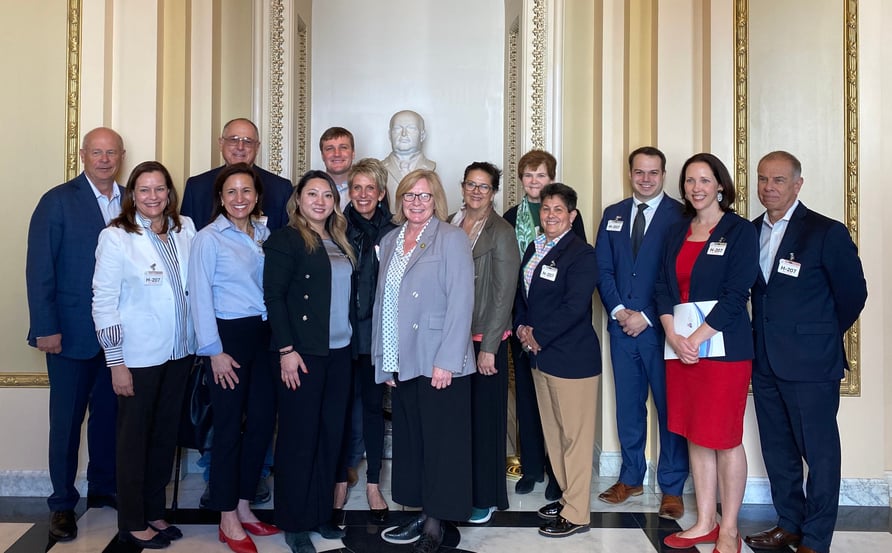
USDEC staff and members of USDEC’s Operating Committee met with Rep. Michelle Fischbach (center) during their visit to Capitol Hill this week to talk dairy trade priorities.
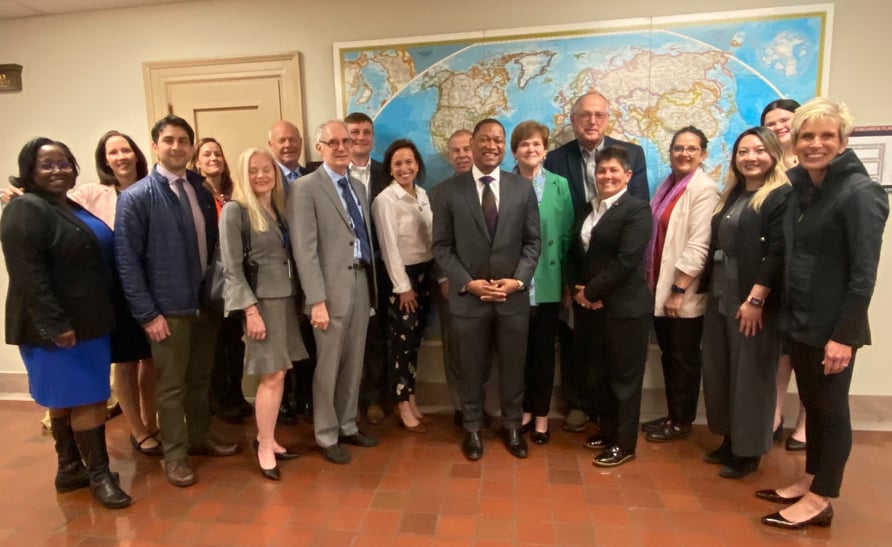
Fly-in participants with FAS and AMS staff, including FAS Administrator Daniel Whitley (center front, left of Krysta Harden).
Events
World Dairy Summit registration launches
On Monday, registration officially opened for the International Dairy Federation (IDF) World Dairy Summit 2023, which will be held Oct. 16-19, 2023 in Chicago. The Summit—the world’s largest global dairy conference—is returning to the United States for the first time in 30 years.
The United States National Committee to IDF (US-IDF) is hosting the event and expects more than 1,000 industry leaders, scientists and producers from around the world to attend. USDEC’s Nick Gardner, USDEC senior vice president, Sustainability and Multilateral Affairs, is chair of US-IDF, which represents the United States dairy industry on the global IDF stage. Shawna Morris, USDEC senior vice president, Trade Policy, serves on the US-IDF executive committee. The two are co-chairs for the Summit.
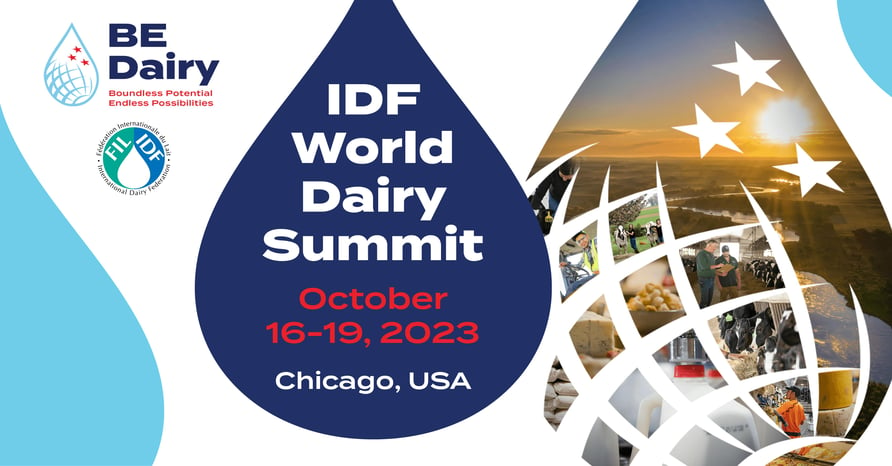
WDS opportunities
Under the theme “BE Dairy…Boundless Potential and Endless Possibilities,” the Summit’s immersive program will bring together dairy leaders and renowned experts to address dairy’s most significant opportunities in today’s dynamic global marketplace.
“BE Dairy really speaks to the optimism that our industry has for the future, certainly from an export potential for growth, but also in terms of our ability to deliver against our sustainability objectives while continuing to be that nutritious source for the world,” said Gardner.
The Summit’s expo will showcase dairy companies, suppliers, dairy trade organizations and products while more than 23 thematic sessions offer content from health and nutrition to sustainable production, consumer expectations, policy and innovation. Attendees will also have the option to register for half-day, one-day and two-day farm and technical tours showcasing the diversity of U.S. dairy farms, research centers, processing facilities and retail in America’s heartland states of Michigan, Wisconsin, Illinois and Indiana.
Register now!
For more information, click here. Anyone who registers by June 30, 2023, will receive the reduced early bird rate.
U.S. dairy presents at Panama/Central America events
USDEC participated in back-to-back U.S. dairy marketing events in Panama over the past two weeks exploring export opportunities in Central America.
USDA Under Secretary for Trade and Foreign Agricultural Affairs Alexis Taylor led a delegation of more than 25 U.S. agribusinesses and food and beverage organizations to Panama City March 19-23. USDEC, DairyAmerica, Leprino Foods and Tedford/Tellico joined the trip, which included direct engagement with potential buyers from across Central America, in-depth market briefings and on-site visits.
“International trade is built on developing successful relationships between U.S. producers and the distributors and consumers in foreign markets,” Taylor said.
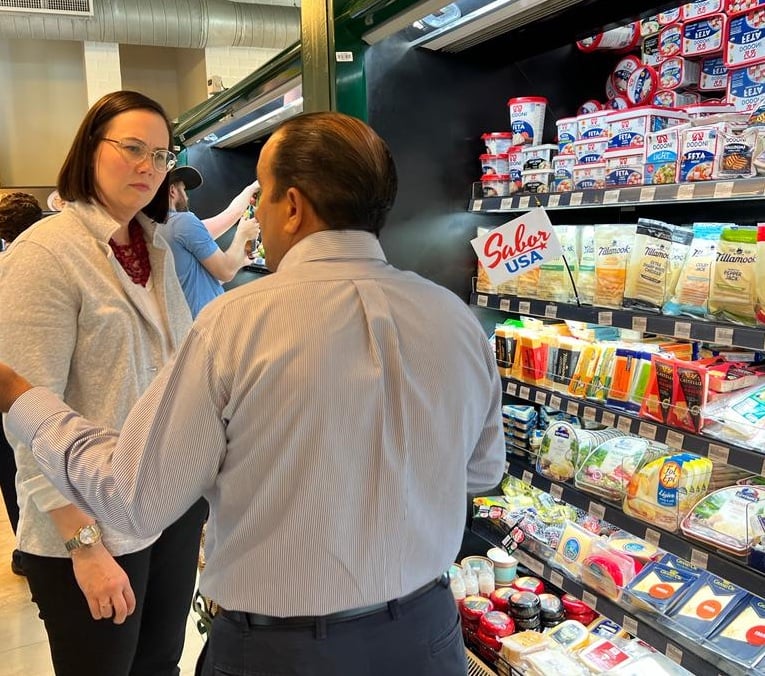
Alexis Taylor (left), USDA undersecretary for trade and foreign agricultural affairs, gets a look at the U.S. cheese section on a tour of a Grand Deli Gourmet store in Panama. Grand Deli Gourmet operates 20 stores in the country.
On March 28-30, USDEC operated a booth at the Expocomer international trade exhibition in Panama City. The show, which focuses on three business sectors, including food and ag products, attracted visitors from across Central America. Because it was the sole dairy booth, USDEC was popular among potential dairy purchasers. Staff reports that major buyers from across the region visited the booth to discuss how U.S. dairy can help them increase dairy consumption and sales, with a particular interest in milk powder and cheese.
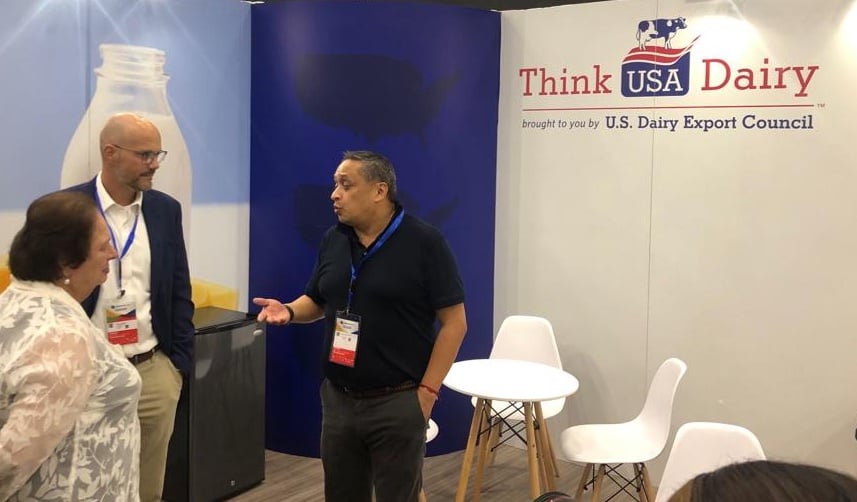
Left to right: U.S. Ambassador to Panama Mari Carmen Aponte, Agricultural Attaché from U.S. Embassy in Panama Pete Olson, and USDEC Mexico Business Development Manager Edgar Garcia at the USDEC booth at Expocomer in Panama City.
Trade Policy
Castaneda strengthens U.S. dairy ties with Mexico
USDEC Executive Vice President for Policy Development and Strategy Jaime Castaneda visited Mexico last week for a series of meetings with the Mexican dairy sector and representatives of the Mexican government.
Castaneda met with Víctor Villalobos, Mexico’s Secretary of Agriculture; Homero Garcia, the new president of the Confederación Nacional de Organizaciones Ganaderas (CNOG); Ricardo Villavicencio Contreras, the new president of Cámara Nacional de Industriales de la Leche (CANILEC), among other Mexican government and dairy industry officials.
The meetings were part of USDEC’s long-standing, continuous efforts to strengthen bilateral ties between the United States and Mexico, address potential issues that might undermine trade and increase dairy consumption to the mutual benefit of both countries.
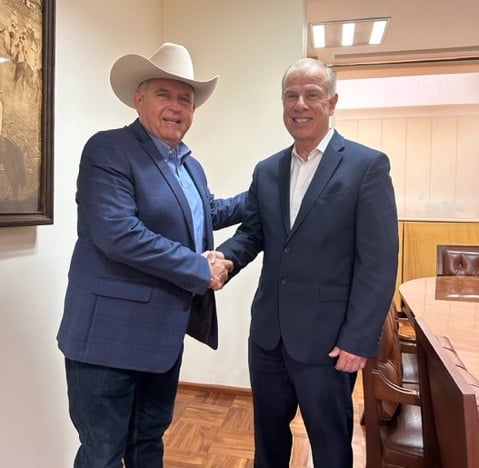
Jaime Castaneda (right) shakes hands with Homero Garcia, the new president of CNOG, Mexico’s influential livestock producer organization, during his trip to Mexico last week to reaffirm the U.S.-Mexico dairy relationship and common goals.
Supply Chain
USDEC, supply chain stakeholders urge administration to help resolve West Coast port labor dispute and avoid disruptions
On March 24, USDEC joined more than 200 groups representing importers, exporters, and others throughout the shipping supply chain in sending a letter urging the Biden administration to take a more active role in resolving the West Coast port labor dispute so goods continue to flow through the ports without disruptions.
Negotiations between the International Longshore and Warehouse Union and the Pacific Maritime Association have been ongoing for more than 10 months. However, talks stalled last summer and media reports last week suggested tensions appear to be rising. This contentious situation adds further uncertainty at a time when the supply chain continues to grapple with pandemic-related challenges and inflation, all amid the annual shipping contract season.
Given that Former Secretary of Labor Marty Walsh left his role earlier this month, the letter asks President Biden to name a new point person to help bring the two parties to the table to find a resolution. Current Deputy Secretary of Labor Julie Su has been nominated to lead the department but has not yet been confirmed by the Senate.
The joint letter also raises concerns about the recent, significant shift in cargo flows away from the West Coast ports due to the labor dispute. Many importers started diverting their cargoes to East and Gulf Coast ports last summer. Last month, container volumes plunged at the Port of Los Angeles (down 43 percent from a record high a year ago) and the Port of Oakland (down 21 percent).
“The longer there is no ratified contract only increases the probability that some portion of the freight will never return to the West Coast ports,” the letter states.
West Coast ports are a critical gateway for U.S. dairy exports. Lingering disputes like this add to the negative perceptions that some international buyers have about U.S. logistics capabilities. While there is little that exporters can do to speed up the negotiation process, USDEC will continue to call attention to the issue while working to strengthen the transportation supply chain through the implementation of the Ocean Shipping Reform Act and other efforts.
Strategic Insights
New trends and insights on South Korea
USDEC’s Strategic Insights department has released a new Global Consumer Trends & Insights Snapshot free to members: Global Consumer Trends & Insights: South Korea. South Korea is the United States’ fifth largest dairy export market and is poised for continued growth moving forward. Driven by strong cheese demand, particularly in foodservice, Korean consumers are increasingly incorporating dairy into their daily lives.
In Case You Missed It...
U.S. Dairy Exporter Blog
Market analysis, research and news subscribe hereUSDEC Twitter feed
Follow us here.